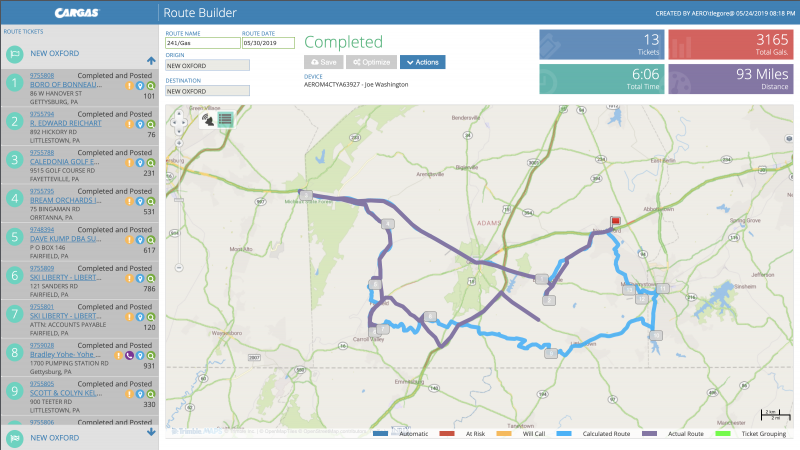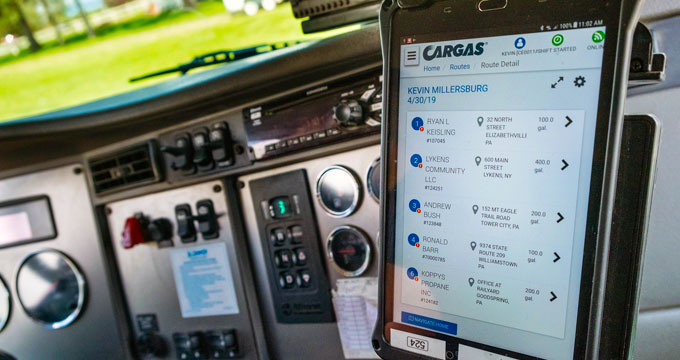18 Ways Software Can Improve Scheduling, Routing, and Dispatching
Fuel dealers everywhere are trying to squeeze as much efficiency as they can out of the fuel delivery process, and they’re using technology to do it. That’s because the right fuel delivery software combines all the best features for scheduling, routing, and dispatching so you can handle those processes more efficiently than ever. Here are 18 ways Cargas Energy software can impact your fuel delivery business.

Scheduling Features
Multiple delivery management options. You probably manage your customers’ delivery needs in several different ways. You might have some tanks on a regular schedule, some that are monitored, and some that you predict usage for using K-factors and degree days. No matter what method you’re using, Cargas Energy allows you to manage tickets from all of these categories at once. This gives customers the flexibility to call when they need you, and it gives you the ability to promptly fulfill those orders.
Smart forecasting tools. Cargas Energy comes packed with all the forecasting tools necessary to predict your customers’ needs. To streamline your forecasting, use seasonal K-factors or baseloads or view tank monitor readings right in the software. More accurate forecasting means you’re better prepared for future orders.
Tank Monitor integrations. You may struggle to manage tanks with erratic usage. By connecting tank monitors to your fuel delivery system, you can see tank level readings right in the software. This way, you’ll know exactly when to deliver and can avoid runouts.
Calibration tools. Cargas Energy builds upon forecasting capabilities, allowing you to calibrate and improve accuracy. After each delivery, the software knows if a tank is burning through fuel more quickly or more slowly than expected and automatically adjusts K-factors and baseloads for more accurate deliveries in the future. The software also generates reports that allow you to compare the gallons delivered against your projections so you can make adjustments. For example, a K-factor exception report tells you which tanks fall outside the acceptable range between projected gallons and delivered gallons.
Ticket selection filters. You can more easily filter and prioritize your open tickets with Cargas Energy. For instance, you can set up at-risk parameters to flag tanks that urgently require delivery. Filters also let you group tickets by delivery zone, due date, or last delivery date.

Routing Features
Digital routing. Instead of manually sorting paper tickets into routes and trying to put them in the best order, you can use digital methods to optimize your routes for delivery efficiency. Cargas Energy includes several handy organizational tools like drag-and-drop interfaces, so you have the flexibility to reorder tickets and build routes on the fly.
Integrated routing. Tired of exporting tickets to a separate application for routing? Cargas Energy offers integrated routing tools so you can handle the entire scheduling, routing, and dispatching process in one place.
Visual plotting. Cargas Energy lets you plot tickets on a map and make adjustments before finalizing a route. Imagine you’ve plotted out one route on the map, and you notice half of the tickets are grouped in the northern part of the delivery zone, and the other half are in the south. Rather than assign all of those tickets to the same route, you may decide it’s more efficient to split them into two routes. Visual ticket plotting gives you the insight to make cost-effective, customer-oriented decisions.
Multi-route view. In addition to visual plotting for individual trucks, Cargas Energy lets dispatchers view stops for multiple routes on one map. With the flexibility to see all selected tickets at once and move them between routes, you can further optimize all routes and increase delivery efficiency.
Route optimization. Cargas Energy optimizes your routes so your drivers can deliver as many gallons as possible in as few miles as possible. Route optimization accounts for live traffic and hazmat and truck restrictions, and it provides turn-by-turn directions for drivers to get to each delivery location as quickly as possible.
Origin and destination points. Route optimization also accounts for origin and destination points. This allows you to set up a route so that the driver leaves from a fueling station at the beginning of the day and returns to the same fueling station at the end of the day. That way, the route is optimized not only for the delivery stops but also for the way the driver starts and ends his shift.
Reloading stops. Using Cargas Energy, dispatchers can add reloading stops to routes for trucks that don’t have the capacity to complete all deliveries with one load. For example, if a driver operates a truck with 3,000-gallon capacity but the route requires 5,000 gallons of fuel to complete. The software will identify when the driver will need to reload and optimize the route to account for that stop.

Dispatching Features
Real-time communication. Pairing fuel delivery software with mobile applications allows your office team and drivers to communicate instantly throughout the day. Instead of getting the driver on the phone, all communication can be handled through Cargas Energy.
Wireless dispatching. One component of real-time communication for fuel delivery software is wireless dispatching. Routes can be sent directly to a driver’s mobile device, no matter where they are, no downloads required.
Midday changes. Real-time communication also allows you to make changes whenever they’re needed. Your dispatcher can update routes and tickets in the back office, and the changes are instantly reflected on the driver’s mobile device. This gives you the flexibility to add stops to a route or update prices on tickets.
Track progress throughout the day. As your drivers complete deliveries, tickets are updated in the back office. Using Cargas Energy, you can also see where your drivers are on their routes, their next stop, and what deliveries are still incomplete.
Find the nearest route. Cargas Energy uses the geolocation of your drivers’ mobile devices to identify where they are. If you receive a will-call delivery request, you can use this functionality to find the driver closest to the new stop and add it to their route.
Undelivered tickets. Cargas Energy gives you a better way to manage undelivered tickets. Tickets can remain on the driver’s tablet for the next day, or the driver can return them to the list of unassigned tickets in the back office to be rerouted by the dispatcher.
View Our Cargas Energy Demo
Cargas Energy’s fuel delivery software offers all of these features and more to help you maximize the efficiency of your fuel delivery operations. If you want to learn more about Cargas Energy’s capabilities, check out our demo!